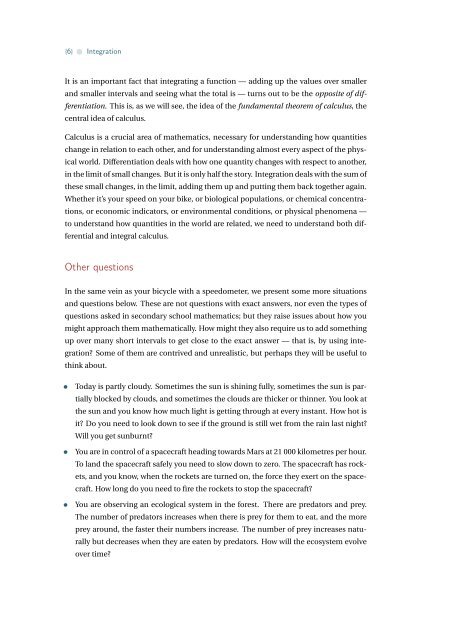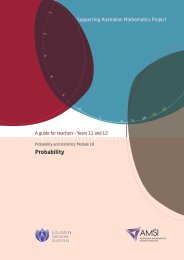Integration - the Australian Mathematical Sciences Institute
Integration - the Australian Mathematical Sciences Institute
Integration - the Australian Mathematical Sciences Institute
Create successful ePaper yourself
Turn your PDF publications into a flip-book with our unique Google optimized e-Paper software.
{6} • <strong>Integration</strong>It is an important fact that integrating a function — adding up <strong>the</strong> values over smallerand smaller intervals and seeing what <strong>the</strong> total is — turns out to be <strong>the</strong> opposite of differentiation.This is, as we will see, <strong>the</strong> idea of <strong>the</strong> fundamental <strong>the</strong>orem of calculus, <strong>the</strong>central idea of calculus.Calculus is a crucial area of ma<strong>the</strong>matics, necessary for understanding how quantitieschange in relation to each o<strong>the</strong>r, and for understanding almost every aspect of <strong>the</strong> physicalworld. Differentiation deals with how one quantity changes with respect to ano<strong>the</strong>r,in <strong>the</strong> limit of small changes. But it is only half <strong>the</strong> story. <strong>Integration</strong> deals with <strong>the</strong> sum of<strong>the</strong>se small changes, in <strong>the</strong> limit, adding <strong>the</strong>m up and putting <strong>the</strong>m back toge<strong>the</strong>r again.Whe<strong>the</strong>r it’s your speed on your bike, or biological populations, or chemical concentrations,or economic indicators, or environmental conditions, or physical phenomena —to understand how quantities in <strong>the</strong> world are related, we need to understand both differentialand integral calculus.O<strong>the</strong>r questionsIn <strong>the</strong> same vein as your bicycle with a speedometer, we present some more situationsand questions below. These are not questions with exact answers, nor even <strong>the</strong> types ofquestions asked in secondary school ma<strong>the</strong>matics; but <strong>the</strong>y raise issues about how youmight approach <strong>the</strong>m ma<strong>the</strong>matically. How might <strong>the</strong>y also require us to add somethingup over many short intervals to get close to <strong>the</strong> exact answer — that is, by using integration?Some of <strong>the</strong>m are contrived and unrealistic, but perhaps <strong>the</strong>y will be useful tothink about.• Today is partly cloudy. Sometimes <strong>the</strong> sun is shining fully, sometimes <strong>the</strong> sun is partiallyblocked by clouds, and sometimes <strong>the</strong> clouds are thicker or thinner. You look at<strong>the</strong> sun and you know how much light is getting through at every instant. How hot isit? Do you need to look down to see if <strong>the</strong> ground is still wet from <strong>the</strong> rain last night?Will you get sunburnt?• You are in control of a spacecraft heading towards Mars at 21 000 kilometres per hour.To land <strong>the</strong> spacecraft safely you need to slow down to zero. The spacecraft has rockets,and you know, when <strong>the</strong> rockets are turned on, <strong>the</strong> force <strong>the</strong>y exert on <strong>the</strong> spacecraft.How long do you need to fire <strong>the</strong> rockets to stop <strong>the</strong> spacecraft?• You are observing an ecological system in <strong>the</strong> forest. There are predators and prey.The number of predators increases when <strong>the</strong>re is prey for <strong>the</strong>m to eat, and <strong>the</strong> moreprey around, <strong>the</strong> faster <strong>the</strong>ir numbers increase. The number of prey increases naturallybut decreases when <strong>the</strong>y are eaten by predators. How will <strong>the</strong> ecosystem evolveover time?
















